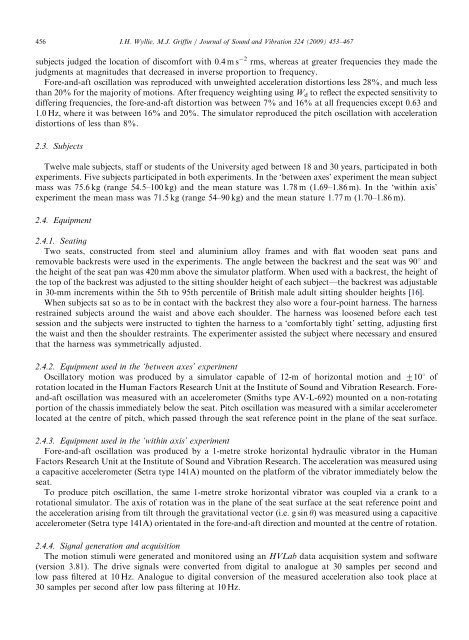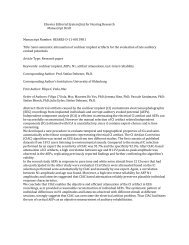Discomfort from sinusoidal oscillation in the pitch and fore-and-aft ...
Discomfort from sinusoidal oscillation in the pitch and fore-and-aft ...
Discomfort from sinusoidal oscillation in the pitch and fore-and-aft ...
You also want an ePaper? Increase the reach of your titles
YUMPU automatically turns print PDFs into web optimized ePapers that Google loves.
456<br />
subjects judged <strong>the</strong> location of discomfort with 0.4 m s 2 rms, whereas at greater frequencies <strong>the</strong>y made <strong>the</strong><br />
judgments at magnitudes that decreased <strong>in</strong> <strong>in</strong>verse proportion to frequency.<br />
Fore-<strong>and</strong>-<strong>aft</strong> <strong>oscillation</strong> was reproduced with unweighted acceleration distortions less 28%, <strong>and</strong> much less<br />
than 20% for <strong>the</strong> majority of motions. After frequency weight<strong>in</strong>g us<strong>in</strong>g W d to reflect <strong>the</strong> expected sensitivity to<br />
differ<strong>in</strong>g frequencies, <strong>the</strong> <strong>fore</strong>-<strong>and</strong>-<strong>aft</strong> distortion was between 7% <strong>and</strong> 16% at all frequencies except 0.63 <strong>and</strong><br />
1.0 Hz, where it was between 16% <strong>and</strong> 20%. The simulator reproduced <strong>the</strong> <strong>pitch</strong> <strong>oscillation</strong> with acceleration<br />
distortions of less than 8%.<br />
2.3. Subjects<br />
Twelve male subjects, staff or students of <strong>the</strong> University aged between 18 <strong>and</strong> 30 years, participated <strong>in</strong> both<br />
experiments. Five subjects participated <strong>in</strong> both experiments. In <strong>the</strong> ‘between axes’ experiment <strong>the</strong> mean subject<br />
mass was 75.6 kg (range 54.5–100 kg) <strong>and</strong> <strong>the</strong> mean stature was 1.78 m (1.69–1.86 m). In <strong>the</strong> ‘with<strong>in</strong> axis’<br />
experiment <strong>the</strong> mean mass was 71.5 kg (range 54–90 kg) <strong>and</strong> <strong>the</strong> mean stature 1.77 m (1.70–1.86 m).<br />
2.4. Equipment<br />
ARTICLE IN PRESS<br />
I.H. Wyllie, M.J. Griff<strong>in</strong> / Journal of Sound <strong>and</strong> Vibration 324 (2009) 453–467<br />
2.4.1. Seat<strong>in</strong>g<br />
Two seats, constructed <strong>from</strong> steel <strong>and</strong> alum<strong>in</strong>ium alloy frames <strong>and</strong> with flat wooden seat pans <strong>and</strong><br />
removable backrests were used <strong>in</strong> <strong>the</strong> experiments. The angle between <strong>the</strong> backrest <strong>and</strong> <strong>the</strong> seat was 901 <strong>and</strong><br />
<strong>the</strong> height of <strong>the</strong> seat pan was 420 mm above <strong>the</strong> simulator platform. When used with a backrest, <strong>the</strong> height of<br />
<strong>the</strong> top of <strong>the</strong> backrest was adjusted to <strong>the</strong> sitt<strong>in</strong>g shoulder height of each subject—<strong>the</strong> backrest was adjustable<br />
<strong>in</strong> 30-mm <strong>in</strong>crements with<strong>in</strong> <strong>the</strong> 5th to 95th percentile of British male adult sitt<strong>in</strong>g shoulder heights [16].<br />
When subjects sat so as to be <strong>in</strong> contact with <strong>the</strong> backrest <strong>the</strong>y also wore a four-po<strong>in</strong>t harness. The harness<br />
restra<strong>in</strong>ed subjects around <strong>the</strong> waist <strong>and</strong> above each shoulder. The harness was loosened be<strong>fore</strong> each test<br />
session <strong>and</strong> <strong>the</strong> subjects were <strong>in</strong>structed to tighten <strong>the</strong> harness to a ‘comfortably tight’ sett<strong>in</strong>g, adjust<strong>in</strong>g first<br />
<strong>the</strong> waist <strong>and</strong> <strong>the</strong>n <strong>the</strong> shoulder restra<strong>in</strong>ts. The experimenter assisted <strong>the</strong> subject where necessary <strong>and</strong> ensured<br />
that <strong>the</strong> harness was symmetrically adjusted.<br />
2.4.2. Equipment used <strong>in</strong> <strong>the</strong> ‘between axes’ experiment<br />
Oscillatory motion was produced by a simulator capable of 12-m of horizontal motion <strong>and</strong> 7101 of<br />
rotation located <strong>in</strong> <strong>the</strong> Human Factors Research Unit at <strong>the</strong> Institute of Sound <strong>and</strong> Vibration Research. Fore<strong>and</strong>-<strong>aft</strong><br />
<strong>oscillation</strong> was measured with an accelerometer (Smiths type AV-L-692) mounted on a non-rotat<strong>in</strong>g<br />
portion of <strong>the</strong> chassis immediately below <strong>the</strong> seat. Pitch <strong>oscillation</strong> was measured with a similar accelerometer<br />
located at <strong>the</strong> centre of <strong>pitch</strong>, which passed through <strong>the</strong> seat reference po<strong>in</strong>t <strong>in</strong> <strong>the</strong> plane of <strong>the</strong> seat surface.<br />
2.4.3. Equipment used <strong>in</strong> <strong>the</strong> ‘with<strong>in</strong> axis’ experiment<br />
Fore-<strong>and</strong>-<strong>aft</strong> <strong>oscillation</strong> was produced by a 1-metre stroke horizontal hydraulic vibrator <strong>in</strong> <strong>the</strong> Human<br />
Factors Research Unit at <strong>the</strong> Institute of Sound <strong>and</strong> Vibration Research. The acceleration was measured us<strong>in</strong>g<br />
a capacitive accelerometer (Setra type 141A) mounted on <strong>the</strong> platform of <strong>the</strong> vibrator immediately below <strong>the</strong><br />
seat.<br />
To produce <strong>pitch</strong> <strong>oscillation</strong>, <strong>the</strong> same 1-metre stroke horizontal vibrator was coupled via a crank to a<br />
rotational simulator. The axis of rotation was <strong>in</strong> <strong>the</strong> plane of <strong>the</strong> seat surface at <strong>the</strong> seat reference po<strong>in</strong>t <strong>and</strong><br />
<strong>the</strong> acceleration aris<strong>in</strong>g <strong>from</strong> tilt through <strong>the</strong> gravitational vector (i.e. g s<strong>in</strong> y) was measured us<strong>in</strong>g a capacitive<br />
accelerometer (Setra type 141A) orientated <strong>in</strong> <strong>the</strong> <strong>fore</strong>-<strong>and</strong>-<strong>aft</strong> direction <strong>and</strong> mounted at <strong>the</strong> centre of rotation.<br />
2.4.4. Signal generation <strong>and</strong> acquisition<br />
The motion stimuli were generated <strong>and</strong> monitored us<strong>in</strong>g an HVLab data acquisition system <strong>and</strong> software<br />
(version 3.81). The drive signals were converted <strong>from</strong> digital to analogue at 30 samples per second <strong>and</strong><br />
low pass filtered at 10 Hz. Analogue to digital conversion of <strong>the</strong> measured acceleration also took place at<br />
30 samples per second <strong>aft</strong>er low pass filter<strong>in</strong>g at 10 Hz.
















